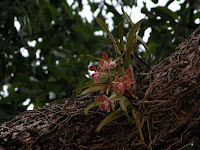

Sesamum mulayanum


Martynia annua
FAMILY OF THE WEEK:PEDALIACEAE
In India it is represented by three genera and seven species occurring chiefly in south India. Martyniaceae is considered as a separate family by some.
Vegetative characters:
Annual or perennial herbs or rarely shrubs. Sometimes as in Martynia, the roots are tuberous. The leaves are opposite, exstipulate, simple entire lobed or divided.
Inflorescence and flowers:
The flowers are usually axillary solitary or in simple cyme or terminal raceme as in Martynia. At the base of the flower stalk characteristic glands are present which metamorphosed flowers are.
The flowers are perfect bisexual zygomorphic and hypogynous. The calyx is of usually five more or less united or distinct sepals. The corolla is gamopetalous, tubular-ventricose, limb obscurely bilabiate, five imbricate lobes. The stamens are usually foue, didynamous and epipetalous on the corolla tube. The fifth posterior stamen is represented by a small staminode. In Martynia there are only two fertile stamens and the remaining three are reduced to staminodes. The anthers are dithecous, introrsr and dehiscing longitudinally.
The gynoecium is bicarpellary and syncarpous with a superior ovary. The style is one and slender and the stigma is bilobed. A nectar secretins disc is present at the base of the ovary.
Fruits and the seeds:
The fruit is an indehiscent or dehiscent capsule often with a woody endocarp which is often horned or prickly. In Martynia the fruit bears two long curved horns.
Pollination and dispersal:
The flowers are often protandrous and are pollinated by insects which visit them for nectar.
The fruits are adapted for dispersal by large mammals. The fruits are armed with adhesive spines or hooks.
Examples:
Sesamum indicum
Sesamum mulayanum
Sesamum laciniatum
Martynia annua
Pedalium murex




















